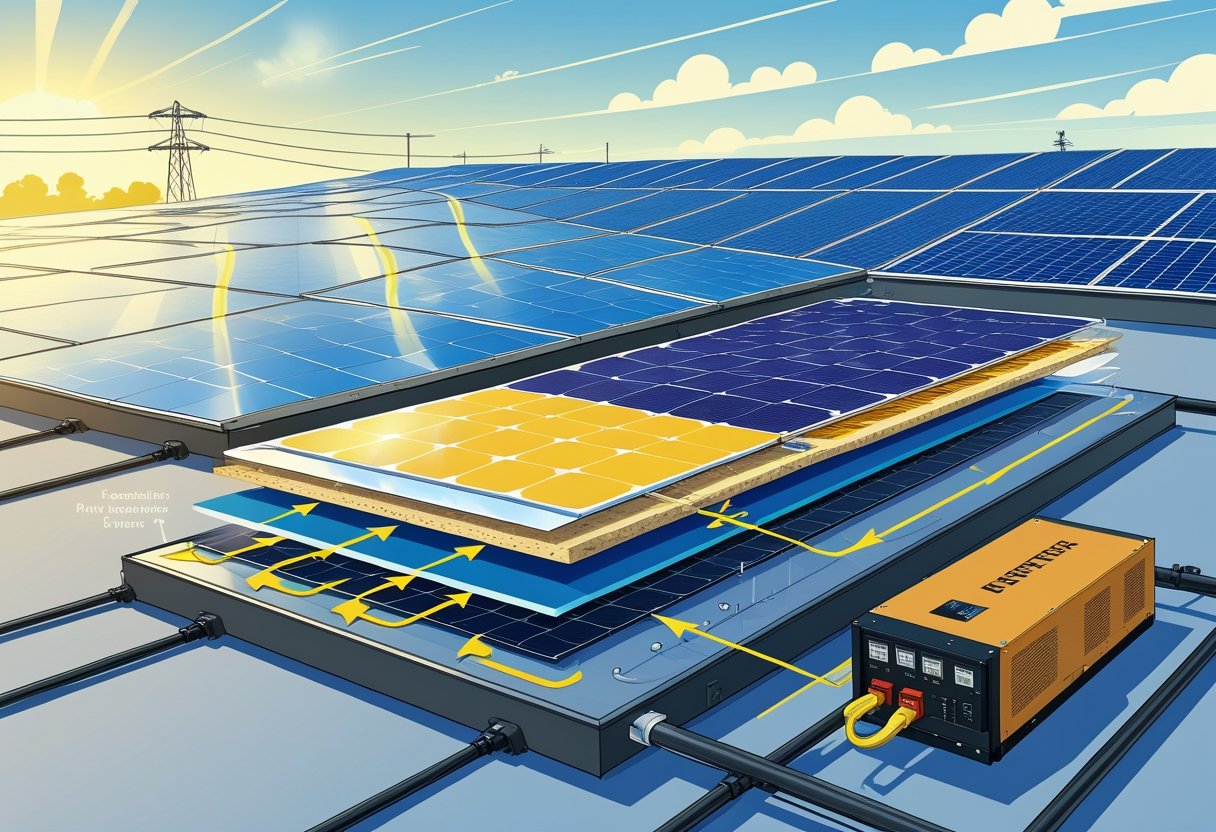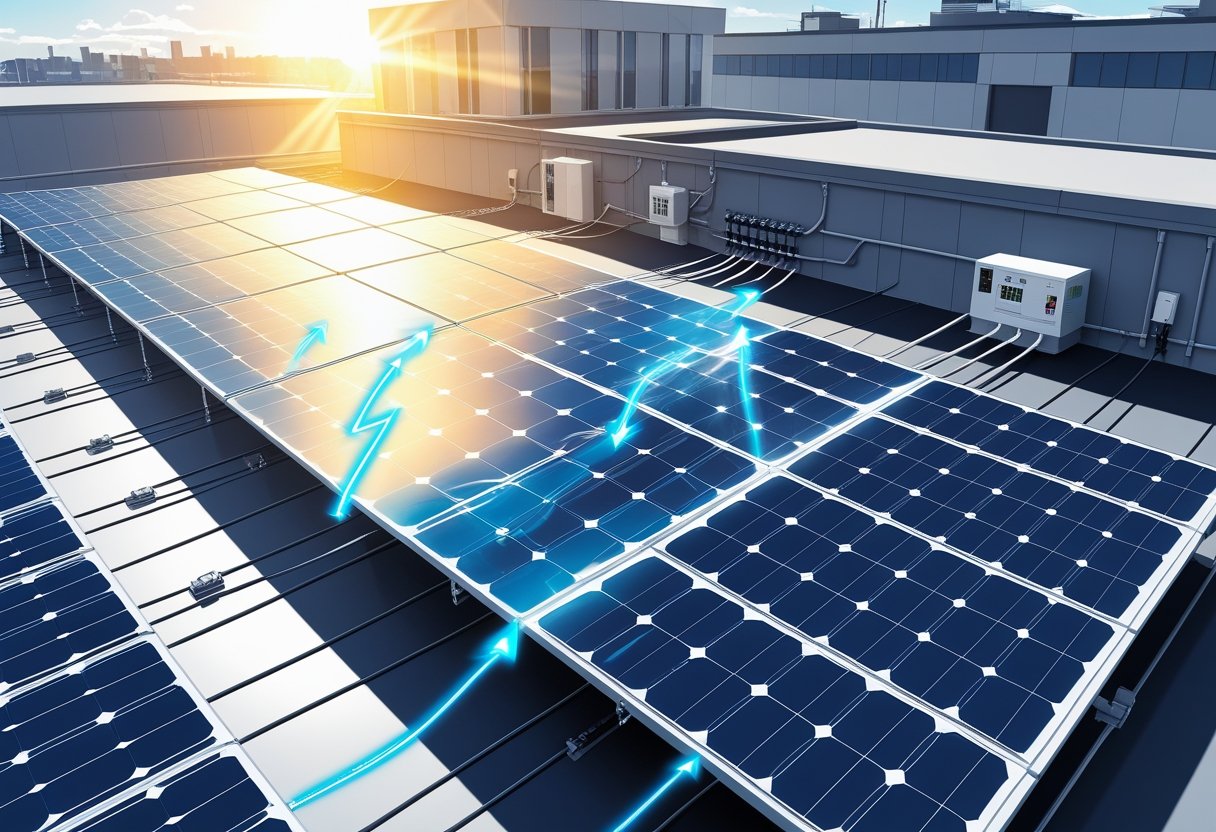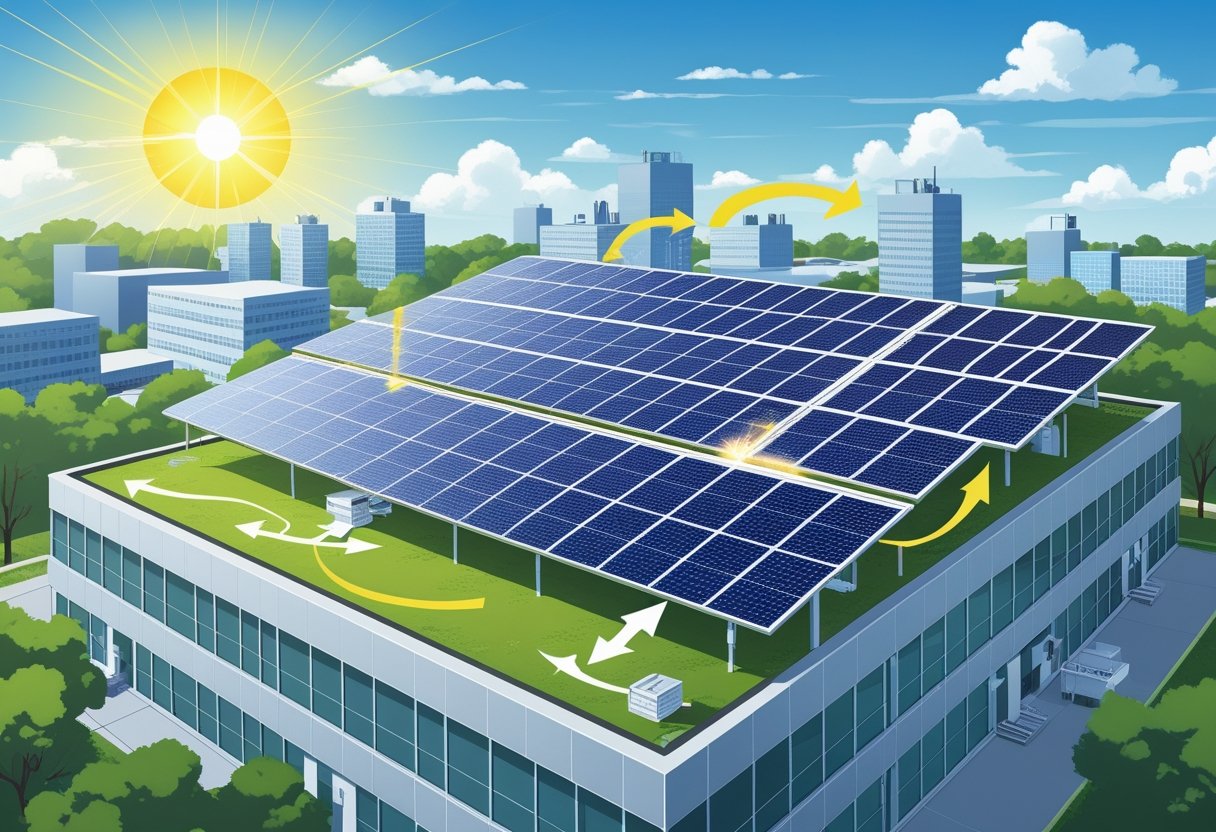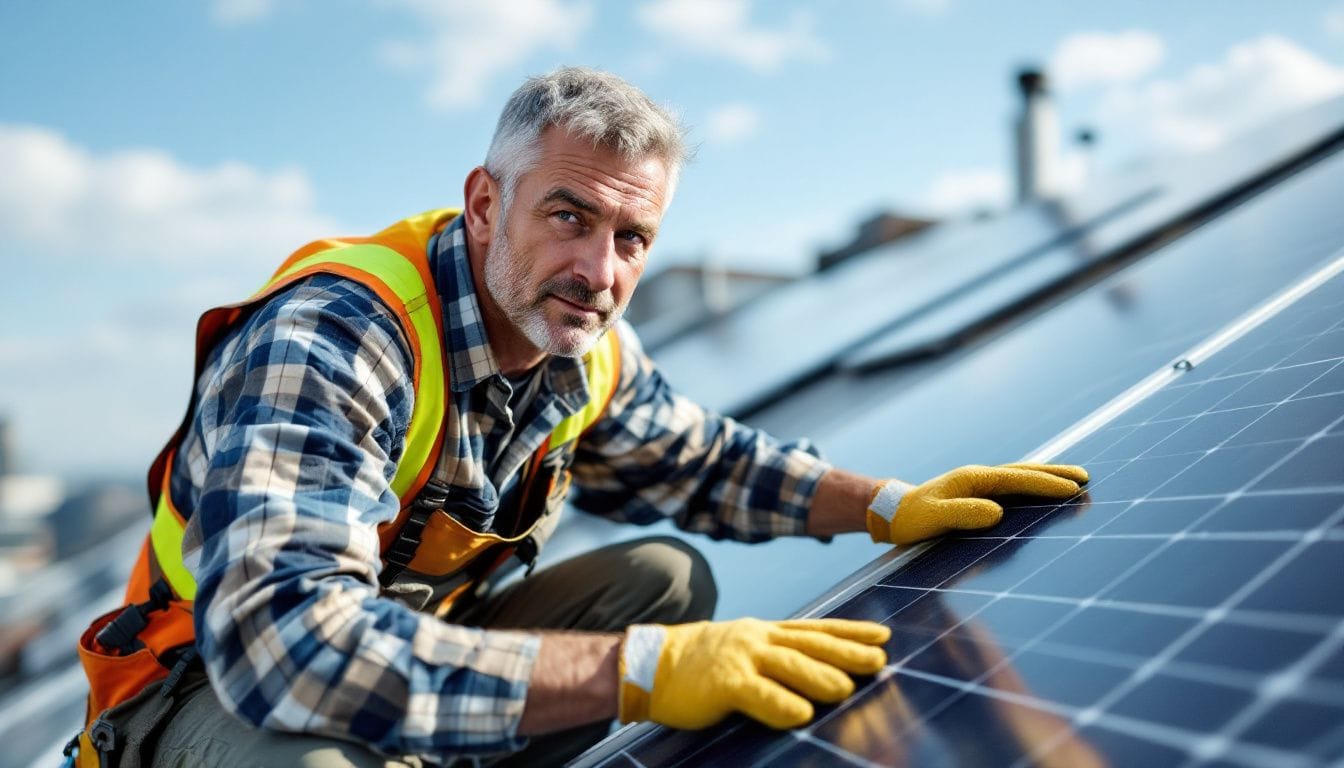How Do Commercial Solar Panels Work?
Commercial solar panels convert sunlight into electricity by using specialised cells that capture solar energy and turn it into usable power. This process involves solar cells generating direct current electricity, which an inverter then changes into alternating current suitable for your business needs. The system’s design adapts to the higher energy demands of commercial sites, making it more efficient than typical residential setups.
You will find that commercial solar panels are generally larger and more powerful, built to meet the unique requirements of different businesses. Because these systems harness renewable energy directly on-site, they reduce reliance on traditional power grids and can significantly lower operational costs. Understanding how these panels work helps clarify why many companies choose solar energy as a reliable, long-term solution.
Exploring the technology behind commercial solar panels reveals how layers of silicon cells, protective glass, and wiring come together to create a seamless energy conversion system. You will also learn how factors like panel type and installation impact overall efficiency, encouraging smarter decisions for your property. As a result, you gain practical insight into how solar installation can contribute to sustainability and cost savings.
Core Technology Behind Commercial Solar Panels

Commercial solar panels rely on a process that transforms sunlight into usable electricity for your business. You’ll find that the technology involves capturing solar energy, converting it into electrical currents, and managing this power effectively. The system’s functionality depends on specific components working together to deliver clean energy.
Photovoltaic Effect Explained
The photovoltaic effect is the core principle behind your commercial solar panels. When sunlight hits the photovoltaic cells, it generates an electrical charge. These cells are made of semiconductor materials, typically silicon, which release electrons when exposed to solar radiation.
This movement of electrons creates a flow of direct current (DC) electricity. The process is purely physical and chemical, allowing sunlight—a renewable energy source—to be converted directly into electrical current without emissions.
You can think of the photovoltaic effect as the initial step that captures the sun’s energy and produces the raw electrical power your system relies on.
Main Components (Panels, Inverters, Mounting, Cabling)
Your commercial solar setup consists of several key parts. The solar panels contain photovoltaic cells that generate DC power. These panels are installed on mounting racks designed to optimise sun exposure and ensure stability.
An inverter then converts that DC electricity into alternating current (AC), which your building can use. You might find either string inverters, managing several panels at once, or microinverters attached to individual panels, improving efficiency by handling energy conversion locally.
Other essential components include electrical cabling, connecting panels and inverters, ensuring safe and efficient power transmission across your system.
How Energy Conversion Happens
Energy conversion begins as sunlight creates DC electricity via photovoltaic cells. This DC current flows to the inverter, where it changes into AC power, compatible with your commercial site’s electrical grid.
Because most commercial equipment operates on AC electricity, converting the current is crucial for practical use. The inverter’s role is pivotal because it ensures the clean energy produced integrates smoothly with your existing electrical system.
This seamless transfer from solar energy to usable electrical current enables your business to run on a reliable and renewable power supply.
Step-By-Step: How Commercial Solar Panels Operate

Commercial solar systems work by capturing sunlight, converting it into electricity, and managing that power to meet the energy needs of commercial buildings. The process involves producing electricity during the day, storing or using that electricity efficiently, and handling excess power with grid interaction.
Daytime Electricity Generation
Your commercial solar panels contain photovoltaic cells that convert sunlight into direct current (DC) electricity. These silicon cells absorb solar energy, which excites electrons and produces a flow of electricity.
Because commercial solar panels are often installed in series, they maximise energy output across rooftops or open spaces. The generated DC electricity is then sent to an inverter, which converts it into alternating current (AC) electricity compatible with your building’s systems.
This process reduces your reliance on traditional energy sources and cuts electricity bills. The amount of electricity generated depends on factors like panel size, sunlight intensity, and installation angle.
Storing And Using Generated Power
Once your solar power system produces electricity, you can either consume it immediately or store it for later use. Solar batteries or energy storage systems capture excess electricity produced during peak sunlight hours.
Storing electricity means you have power available during cloudy periods or after sunset, which helps smooth your energy consumption. Using stored electricity reduces your demand on the grid and lowers your commercial building’s overall energy costs.
If your energy storage system is sized correctly, it supports continuous operations and handles fluctuations in energy output, ensuring your energy needs are met without interruption.
Connecting To The Grid (Exporting Excess Power)
When your commercial solar panel system produces more electricity than your building consumes, the surplus energy can be exported to the grid. This connection is regulated through a process called net metering.
Net metering credits you for the excess power, which may offset your future electricity bills. This arrangement benefits your commercial solar system by maximising the value of your energy production.
To connect effectively, your system must synchronise with the grid via the inverter. This ensures safe and stable power flow, preventing overloading or disturbances in the commercial electricity network.
Efficiency Factors In Commercial Solar Systems

Several aspects impact the output and sustainability of commercial solar setups. These include the quality of the panels, their installation specifics, and ongoing maintenance practices. Understanding these elements helps you optimise energy generation and reduce your system’s carbon footprint.
Panel Quality And Technology
Your choice of panel type significantly affects efficiency and overall performance. Monocrystalline solar panels generally offer higher panel efficiency, reaching up to 25%, due to their uniform silicon structure. Polycrystalline panels often perform slightly lower but come at reduced costs. Thin-film solar panels provide more flexibility but usually have lower efficiency and shorter lifespan.
Advanced technologies such as power optimisers and anti-reflective coatings improve output by mitigating shading effects or surface losses. High-quality materials also enhance durability, supporting long-term resilience and maintaining sustainable energy production. Investing in better technology lowers your system’s carbon emissions by maximising renewable energy conversion.
Positioning And Installation Considerations
Correct panel orientation and tilt angles are crucial, as sunlight exposure directly influences energy yield. Installing panels where shading is minimal ensures you avoid power losses, which can otherwise reduce system efficiency by up to 20%. The system size should be calculated carefully to meet your business’s energy demands while maximising rooftop or land use.
You should consider local weather and geographic factors since sunlight availability changes by location, impacting performance. Installation quality also affects durability, which protects your environmental benefits over time. Using mounting systems designed for airflow helps prevent overheating and maintains optimal panel function.
Maintenance And Performance Monitoring
Regular maintenance keeps your system performing close to its peak. Cleaning panels from dust and debris ensures consistent sunlight absorption, while timely repairs address issues that could otherwise lower efficiency. Implementing a monitoring system is essential; it tracks output variations and spotlights underperformance or faults.
An efficient energy management system can provide real-time insights, enabling you to adjust operations instantly. This reduces downtime and helps to sustain your system’s productivity, contributing to long-term reductions in carbon footprint. Continual monitoring is a key step to support eco-friendly and sustainable energy solutions.
Business Benefits Of Commercial Solar Panels
Installing commercial solar panels brings clear financial and environmental advantages. You can expect to reduce energy expenses markedly, contribute to sustainability goals, and benefit from government support schemes that make the initial costs more manageable.
Cost Savings And ROI
Commercial solar panels lower your energy bills by generating electricity onsite, reducing dependence on grid power. This means you can cut operational costs substantially over time. The initial cost of commercial solar panels ranges typically from £16,000 to £60,000 for systems between 20kW and 50kW, suitable for small to medium enterprises.
Return on investment (ROI) often occurs within 4 to 5 years due to significant annual savings on energy and potential revenue generation through the Smart Export Guarantee (SEG). After breaking even, solar panels provide long-term savings as energy costs continue to rise. You can also improve your budget management with predictable, lower energy expenses.
Sustainability And Net Zero Targets
By adopting commercial solar panels, you reduce your carbon footprint and directly contribute to net zero targets. Onsite renewable energy generation promotes energy independence, helping your business avoid volatility in fossil fuel prices and supply issues.
Solar power aligns with many businesses’ sustainability commitments and enhances reputation with eco-conscious clients and partners. It offers a clean, renewable source of energy that operates silently and reliably for over 25 years with minimal maintenance. These factors make commercial solar a sustainable long-term energy solution.
Government Incentives & Tax Benefits
Various fiscal incentives and government schemes can reduce the upfront initial cost of installing commercial solar systems. These include the Annual Investment Allowance (AIA), which allows you to deduct the full cost of solar panels from your taxable profit in the first year.
Additional tax credits and the First Year Allowance provide further financial relief, accelerating your return on investment. The Smart Export Guarantee (SEG) also lets you earn payments by exporting unused electricity to the grid. You may find government grants or funding options specifically designed to support solar installation, which helps improve affordability and accessibility.
Common Myths And Questions About Commercial Solar
Understanding how commercial solar panels perform and what challenges you might face is crucial for making informed decisions. You should know about their effectiveness in varying climates, adaptability to different business sizes, and how long these systems remain reliable under warranty.
Reliability In The UK Climate
Many believe solar panels do not work well in the UK due to its cloudy weather. However, solar panels generate electricity from daylight, not only direct sunlight, which means they still produce power on overcast days.
You can expect commercial solar panels to operate efficiently throughout the year because their technology captures diffused sunlight. This steadiness in energy generation means your business won’t face unexpected drops in electricity production due to the typical UK weather.
Panels are tested to withstand various weather conditions, including rain and wind, which ensures continuous performance. Thus, your commercial system remains dependable despite the often grey skies.
Scalability For Different Businesses
Commercial solar systems can be customised to fit diverse energy demands and site sizes. Whether your business uses a small factory roof or a large warehouse with vast space, you can scale the number of solar panels accordingly.
This adaptability means you can start with a basic system and expand it later as your energy needs grow or change. Your system size directly influences the amount of power generated and your potential savings on electricity costs.
Because commercial systems are modular, you can combine different configurations to suit your budget or site constraints without compromising efficiency or performance.
Typical Lifespan And Warranty
Commercial solar panels generally come with warranties lasting between 25 and 30 years. These guarantees assure you that panels will maintain at least 80% of their rated power output by the end of the warranty period.
Warranties usually cover manufacturing defects and performance degradation, which means manufacturers commit to your panels producing electricity reliably for decades. This long-term coverage protects your business from unexpected maintenance costs.
The lifespan often exceeds the warranty, with many panels continuing to function efficiently beyond 30 years, though with a slight decrease in output. By choosing panels with solid warranties, you ensure durable protection for your commercial solar system.
Integrating Solar Panels Into Existing Commercial Properties
Adding solar panels to your current commercial building involves assessing the site’s roof condition, layout, and energy needs. You should consider whether retrofitting or a new build installation suits your property best, how this affects your property’s market value, and which permissions must be secured before installation.
Retrofit Vs New Build Installations
Retrofitting solar panels applies to properties already constructed, requiring evaluation of the roof condition and structural capacity. Flat roofs are common for commercial solar installations because they allow flexible panel placement and easier maintenance. However, older roofs may need reinforcement, increasing setup time and costs.
New build installations integrate solar systems during construction, allowing optimal positioning and wiring for energy efficiency. Retrofitting involves additional electrical work, like connecting to your current inverter system, which can be more complex. A detailed site assessment is essential in both cases to align the system with your building’s energy demands.
Impact On Building Value
Installing solar panels typically leads to increased property value by attracting tenants prioritising sustainability. Commercial buildings with solar offer lower operational costs due to reduced grid reliance, which enhances appeal in competitive markets.
The boost in value depends on panel quality, system size, and savings on energy bills. Buildings with well-maintained solar installations signal modern energy solutions to prospective buyers or renters. Therefore, solar installations can differentiate your property positively without compromising functionality or appearance.
Planning Permissions And Regulations (Bridge To “Commercial Solar Planning Guidance”)
Before installing solar panels commercially, you must navigate planning permissions and comply with local regulations. Rules vary depending on your building’s location, heritage status, and roof type, so consulting relevant authorities is necessary to avoid delays.
Permitting often requires submitting documents detailing the solar panel installation’s impact on building structure and environment. Some properties may qualify for permitted development rights, removing the need for full planning consent, but it’s vital to confirm your eligibility. Dealing with regulations early ensures your commercial solar setup proceeds smoothly and within legal frameworks.
Why Choose Commercial Solar UK For Commercial Solar Solutions?
Choosing your commercial solar provider requires assurance in skill, method, and customer care. You want a team that handles every stage carefully, from expertise in design to reliable installation and maintenance. Clear communication and proven results ensure your solar system performs optimally and fits your business needs.
Expertise And Project Portfolio
Your company needs specialists with deep knowledge of commercial solar technologies and varying business demands. We have completed numerous projects across industries, adapting systems to roof type, energy usage, and local conditions. This breadth means we can tailor solutions that maximise efficiency and output.
Our portfolio shows consistent results, with many installations delivering expected returns and positive feedback from our clients. Your business benefits from our technical skill and ability to navigate planning permissions or grid connection processes smoothly.
Our Installation Process
Our installation process follows strict protocols to ensure safety, compliance, and minimal disruption to your operations. We begin with a comprehensive site survey, evaluating structural integrity and solar exposure to choose the ideal panel layout.
Installation teams work efficiently while maintaining quality standards, using equipment that meets industry regulations. We coordinate timelines to fit your schedule, which means your solar system is up and running promptly and correctly.
Ongoing Support And Maintenance Services
Maintaining your solar panels is essential for sustained performance and return. We provide scheduled inspections and cleaning recommendations tailored to your environment, preventing energy loss from dirt or damage.
Our ongoing support includes monitoring system output and troubleshooting any issues early. Customer reviews highlight our responsiveness and commitment to keeping systems operational, which reduces downtime and ensures confidence in your renewable energy solution.
Next Steps & Contact Information
Taking action after understanding how commercial solar panels work is crucial to ensure your site gains maximum benefit from solar energy. You will need to assess your property, understand the costs involved, and explore further services to support your solar setup.
Book A Free Site Survey
Scheduling a free site survey is the first tangible step towards installing commercial solar panels. During this visit, a qualified technician will evaluate your property’s roof condition, sun exposure, and structural factors. This assessment determines whether your business premises are suitable for solar panels, which means you avoid unnecessary expenses.
The survey also helps define your energy consumption needs precisely, enabling a tailored solar solution. A clear report will be provided, outlining your site’s potential solar capacity and any limitations. This information is essential to plan the size and layout of the solar system efficiently.
Request A Quote
Once the site survey confirms feasibility, you should request a detailed quote. A comprehensive quote includes the cost of solar panels, installation labour, inverter costs, and any additional equipment like battery storage if necessary. Understanding these expenses upfront helps you budget accurately.
The quotation will also specify project timelines and any maintenance packages available after installation. Some providers offer flexible financing options, allowing you to manage costs more effectively over time. You will receive clear terms so you can make an informed decision without hidden fees.
Explore More About Commercial Solar
To maximise the value of your solar setup, you should explore more detailed information on related topics. Learning about Commercial Solar Installation guides you through the entire mounting and connection process, which clarifies what to expect on installation day.
Understanding Solar PV Maintenance is critical as solar panels require regular checks and cleaning to maintain peak efficiency. Proper upkeep extends the system’s lifespan and sustains your energy savings.
Finally, knowledge of Commercial Battery Storage introduces you to ways of storing excess power for use during non-sunny periods. Battery solutions increase your business’s energy independence and resilience, allowing you to optimise solar energy use even after sunset.

